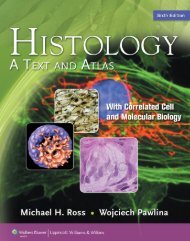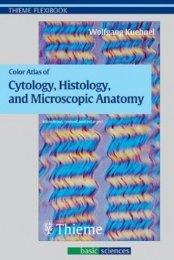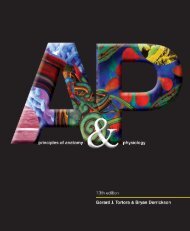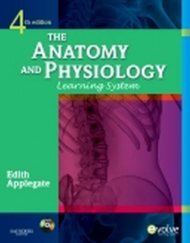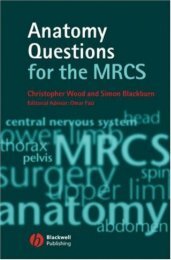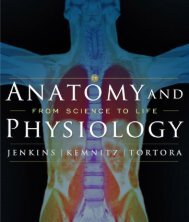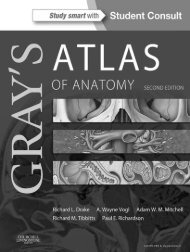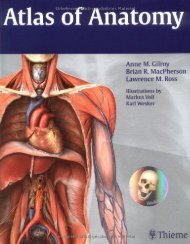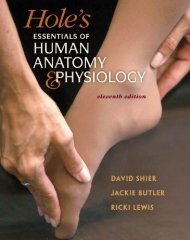- Page 2 and 3: ©2008 F. A. Davis Urinalysis and B
- Page 4 and 5: ©2008 F. A. Davis Urinalysis and B
- Page 6 and 7: ©2008 F. A. Davis To Harry, you wi
- Page 8 and 9: ©2008 F. A. Davis Preface As will
- Page 10 and 11: ©2008 F. A. Davis Reviewers Ellen
- Page 12 and 13: ©2008 F. A. Davis Acknowledgments
- Page 14 and 15: ©2008 F. A. Davis Contents Chapter
- Page 16 and 17: ©2008 F. A. Davis CONTENTS xv Cyto
- Page 18 and 19: ©2008 F. A. Davis CONTENTS xvii Pe
- Page 20 and 21: ©2008 F. A. Davis 1 CHAPTER Safety
- Page 22 and 23: ©2008 F. A. Davis CHAPTER 1 • Sa
- Page 24 and 25: ©2008 F. A. Davis CHAPTER 1 • Sa
- Page 26 and 27: ©2008 F. A. Davis CHAPTER 1 • Sa
- Page 28 and 29: ©2008 F. A. Davis CHAPTER 1 • Sa
- Page 30 and 31: ©2008 F. A. Davis CHAPTER 2 Renal
- Page 32 and 33: ©2008 F. A. Davis CHAPTER 2 • Re
- Page 36 and 37: ©2008 F. A. Davis CHAPTER 2 • Re
- Page 38 and 39: ©2008 F. A. Davis CHAPTER 2 • Re
- Page 40 and 41: ©2008 F. A. Davis CHAPTER 2 • Re
- Page 42 and 43: ©2008 F. A. Davis CHAPTER 2 • Re
- Page 44 and 45: ©2008 F. A. Davis CHAPTER 2 • Re
- Page 46 and 47: ©2008 F. A. Davis CHAPTER 2 • Re
- Page 48 and 49: ©2008 F. A. Davis CHAPTER 3 Introd
- Page 50 and 51: ©2008 F. A. Davis CHAPTER 3 • In
- Page 52 and 53: ©2008 F. A. Davis CHAPTER 3 • In
- Page 54 and 55: ©2008 F. A. Davis CHAPTER 3 • In
- Page 56 and 57: ©2008 F. A. Davis CHAPTER 3 • In
- Page 58 and 59: ©2008 F. A. Davis CHAPTER 3 • In
- Page 60 and 61: ©2008 F. A. Davis CHAPTER 4 Physic
- Page 62 and 63: ©2008 F. A. Davis CHAPTER 4 • Ph
- Page 64 and 65: ©2008 F. A. Davis Table 4-2 Clarit
- Page 66 and 67: ©2008 F. A. Davis CHAPTER 4 • Ph
- Page 68 and 69: ©2008 F. A. Davis CHAPTER 4 • Ph
- Page 70 and 71: ©2008 F. A. Davis CHAPTER 4 • Ph
- Page 72 and 73: ©2008 F. A. Davis CHAPTER 5 Chemic
- Page 74 and 75: ©2008 F. A. Davis CHAPTER 5 • Ch
- Page 76 and 77: ©2008 F. A. Davis CHAPTER 5 • Ch
- Page 78 and 79: ©2008 F. A. Davis CHAPTER 5 • Ch
- Page 80 and 81: ©2008 F. A. Davis CHAPTER 5 • Ch
- Page 82 and 83: ©2008 F. A. Davis CHAPTER 5 • Ch
- Page 84 and 85:
©2008 F. A. Davis CHAPTER 5 • Ch
- Page 86 and 87:
©2008 F. A. Davis CHAPTER 5 • Ch
- Page 88 and 89:
©2008 F. A. Davis CHAPTER 5 • Ch
- Page 90 and 91:
©2008 F. A. Davis CHAPTER 5 • Ch
- Page 92 and 93:
©2008 F. A. Davis CHAPTER 5 • Ch
- Page 94 and 95:
©2008 F. A. Davis CHAPTER 5 • Ch
- Page 96 and 97:
©2008 F. A. Davis CHAPTER 5 • Ch
- Page 98 and 99:
©2008 F. A. Davis CHAPTER 5 • Ch
- Page 100 and 101:
©2008 F. A. Davis CHAPTER 6 Micros
- Page 102 and 103:
©2008 F. A. Davis CHAPTER 6 • Mi
- Page 104 and 105:
©2008 F. A. Davis Lipid Stains: Oi
- Page 106 and 107:
©2008 F. A. Davis CHAPTER 6 • Mi
- Page 108 and 109:
©2008 F. A. Davis CHAPTER 6 • Mi
- Page 110 and 111:
©2008 F. A. Davis CHAPTER 6 • Mi
- Page 112 and 113:
©2008 F. A. Davis CHAPTER 6 • Mi
- Page 114 and 115:
©2008 F. A. Davis CHAPTER 6 • Mi
- Page 116 and 117:
©2008 F. A. Davis CHAPTER 6 • Mi
- Page 118 and 119:
©2008 F. A. Davis CHAPTER 6 • Mi
- Page 120 and 121:
©2008 F. A. Davis Summary of Epith
- Page 122 and 123:
©2008 F. A. Davis CHAPTER 6 • Mi
- Page 124 and 125:
©2008 F. A. Davis CHAPTER 6 • Mi
- Page 126 and 127:
©2008 F. A. Davis CHAPTER 6 • Mi
- Page 128 and 129:
©2008 F. A. Davis CHAPTER 6 • Mi
- Page 130 and 131:
©2008 F. A. Davis CHAPTER 6 • Mi
- Page 132 and 133:
©2008 F. A. Davis CHAPTER 6 • Mi
- Page 134 and 135:
©2008 F. A. Davis CHAPTER 6 • Mi
- Page 136 and 137:
©2008 F. A. Davis CHAPTER 6 • Mi
- Page 138 and 139:
©2008 F. A. Davis CHAPTER 6 • Mi
- Page 140 and 141:
©2008 F. A. Davis CHAPTER 6 • Mi
- Page 142 and 143:
©2008 F. A. Davis CHAPTER 6 • Mi
- Page 144 and 145:
©2008 F. A. Davis CHAPTER 6 • Mi
- Page 146 and 147:
©2008 F. A. Davis CHAPTER 7 Qualit
- Page 148 and 149:
©2008 F. A. Davis CHAPTER 7 • Qu
- Page 150 and 151:
©2008 F. A. Davis CHAPTER 7 • Qu
- Page 152 and 153:
©2008 F. A. Davis CHAPTER 7 • Qu
- Page 154 and 155:
©2008 F. A. Davis CHAPTER 7 • Qu
- Page 156 and 157:
©2008 F. A. Davis CHAPTER 7 • Qu
- Page 158 and 159:
©2008 F. A. Davis CHAPTER 7 • Qu
- Page 160 and 161:
©2008 F. A. Davis CHAPTER 7 • Qu
- Page 162 and 163:
©2008 F. A. Davis CHAPTER 8 Renal
- Page 164 and 165:
©2008 F. A. Davis CHAPTER 8 • Re
- Page 166 and 167:
©2008 F. A. Davis CHAPTER 8 • Re
- Page 168 and 169:
©2008 F. A. Davis CHAPTER 8 • Re
- Page 170 and 171:
©2008 F. A. Davis CHAPTER 8 • Re
- Page 172 and 173:
©2008 F. A. Davis CHAPTER 8 • Re
- Page 174 and 175:
©2008 F. A. Davis CHAPTER 8 • Re
- Page 176 and 177:
©2008 F. A. Davis CHAPTER 8 • Re
- Page 178 and 179:
©2008 F. A. Davis CHAPTER 9 Urine
- Page 180 and 181:
©2008 F. A. Davis Table 9-2 CHAPTE
- Page 182 and 183:
©2008 F. A. Davis CHAPTER 9 • Ur
- Page 184 and 185:
©2008 F. A. Davis CHAPTER 9 • Ur
- Page 186 and 187:
©2008 F. A. Davis CHAPTER 9 • Ur
- Page 188 and 189:
©2008 F. A. Davis Table 9-3 Summar
- Page 190 and 191:
©2008 F. A. Davis CHAPTER 9 • Ur
- Page 192 and 193:
©2008 F. A. Davis CHAPTER 9 • Ur
- Page 194 and 195:
©2008 F. A. Davis CHAPTER 9 • Ur
- Page 196 and 197:
©2008 F. A. Davis 10 CHAPTER Cereb
- Page 198 and 199:
©2008 F. A. Davis CHAPTER 10 • C
- Page 200 and 201:
©2008 F. A. Davis CHAPTER 10 • C
- Page 202 and 203:
©2008 F. A. Davis CHAPTER 10 • C
- Page 204 and 205:
©2008 F. A. Davis CHAPTER 10 • C
- Page 206 and 207:
©2008 F. A. Davis CHAPTER 10 • C
- Page 208 and 209:
©2008 F. A. Davis CHAPTER 10 • C
- Page 210 and 211:
©2008 F. A. Davis CHAPTER 10 • C
- Page 212 and 213:
©2008 F. A. Davis CHAPTER 10 • C
- Page 214 and 215:
©2008 F. A. Davis CHAPTER 10 • C
- Page 216 and 217:
©2008 F. A. Davis CHAPTER 10 • C
- Page 218 and 219:
©2008 F. A. Davis 11 CHAPTER Semen
- Page 220 and 221:
©2008 F. A. Davis Summary of Semen
- Page 222 and 223:
©2008 F. A. Davis CHAPTER 11 • S
- Page 224 and 225:
©2008 F. A. Davis CHAPTER 11 • S
- Page 226 and 227:
©2008 F. A. Davis CHAPTER 11 • S
- Page 228 and 229:
©2008 F. A. Davis CHAPTER 11 • S
- Page 230 and 231:
©2008 F. A. Davis 12 CHAPTER Synov
- Page 232 and 233:
©2008 F. A. Davis CHAPTER 12 • S
- Page 234 and 235:
©2008 F. A. Davis Table 12-5 Chara
- Page 236 and 237:
©2008 F. A. Davis CHAPTER 12 • S
- Page 238 and 239:
©2008 F. A. Davis CHAPTER 12 • S
- Page 240 and 241:
©2008 F. A. Davis 13 CHAPTER Serou
- Page 242 and 243:
©2008 F. A. Davis CHAPTER 13 • S
- Page 244 and 245:
©2008 F. A. Davis CHAPTER 13 • S
- Page 246 and 247:
©2008 F. A. Davis CHAPTER 13 • S
- Page 248 and 249:
©2008 F. A. Davis CHAPTER 13 • S
- Page 250 and 251:
©2008 F. A. Davis CHAPTER 13 • S
- Page 252 and 253:
©2008 F. A. Davis CHAPTER 13 • S
- Page 254 and 255:
©2008 F. A. Davis 14 CHAPTER Amnio
- Page 256 and 257:
©2008 F. A. Davis CHAPTER 14 • A
- Page 258 and 259:
©2008 F. A. Davis CHAPTER 14 • A
- Page 260 and 261:
©2008 F. A. Davis CHAPTER 14 • A
- Page 262 and 263:
©2008 F. A. Davis CHAPTER 14 • A
- Page 264 and 265:
©2008 F. A. Davis 15 CHAPTER Fecal
- Page 266 and 267:
©2008 F. A. Davis CHAPTER 15 • F
- Page 268 and 269:
©2008 F. A. Davis CHAPTER 15 • F
- Page 270 and 271:
©2008 F. A. Davis CHAPTER 15 • F
- Page 272 and 273:
©2008 F. A. Davis CHAPTER 15 • F
- Page 274 and 275:
©2008 F. A. Davis CHAPTER 15 • F
- Page 276 and 277:
©2008 F. A. Davis CHAPTER 15 • F
- Page 278 and 279:
©2008 F. A. Davis Appendix A Urina
- Page 280 and 281:
©2008 F. A. Davis APPENDIX A • U
- Page 282 and 283:
©2008 F. A. Davis APPENDIX A • U
- Page 284 and 285:
©2008 F. A. Davis Appendix B Bronc
- Page 286 and 287:
©2008 F. A. Davis Answers to Case
- Page 288 and 289:
©2008 F. A. Davis Answers to Case
- Page 290 and 291:
©2008 F. A. Davis Answers to Case
- Page 292 and 293:
©2008 F. A. Davis Answers to Study
- Page 294 and 295:
©2008 F. A. Davis Answers to Study
- Page 296 and 297:
©2008 F. A. Davis Abbreviations AA
- Page 298 and 299:
©2008 F. A. Davis Glossary accredi
- Page 300 and 301:
©2008 F. A. Davis Glossary 281 har
- Page 302 and 303:
©2008 F. A. Davis Glossary 283 pre
- Page 304 and 305:
©2008 F. A. Davis Index Page numbe
- Page 306 and 307:
©2008 F. A. Davis Efferent arterio
- Page 308 and 309:
©2008 F. A. Davis Microviscosity:f
- Page 310 and 311:
©2008 F. A. Davis function tests,





